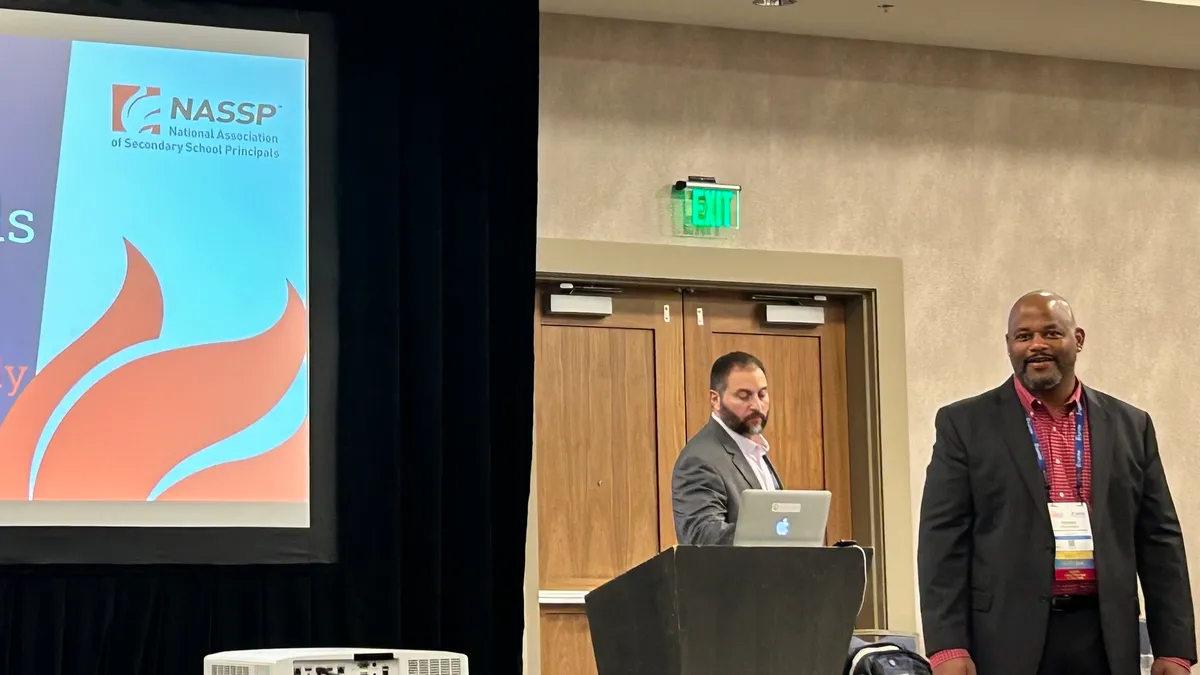DENVER — Harrison Bailey III, principal of Liberty High School in Bethlehem, Pa., understood his community had a broken referral system for mental health providers.
Students in need of outside community mental health resources were waiting months to get help. On a wider scale, Bailey cited a statistic from the Substance Abuse and Mental Health Services Administration, which overall projects that by 2025, there will be a nationwide shortage of 78,050 school counselors, 26,930 mental health counselors and 15,400 psychiatrists.
At Liberty, school counselors were “fighting for services” for their respective students, Bailey said. There were also too few mental health providers in Liberty High School. “The few that we had were flooded,” Bailey said, adding that students across varying degrees of mental health needs were using these services.
For instance, Bailey said that using a scale of 1 to 10 to measure student mental health needs — where a student with a 2 was receiving the same level of services as their peer with an 8 — is a problem, he said.
To address this issue, Bailey and Nikolas Tsamoutalidis, a former Liberty High School assistant principal, shared how they developed a wellness center at the school over the course of six years during a Friday presentation at the National Association for Secondary School Principals’ Ignite 2023 Conference in Denver, Colo.
Don’t overrun the system
Liberty High School’s wellness center opened in fall 2020 under a three-tier pyramid model for student support.
The first tier of support emphasizes building relationships with students and providing professional development for staff. The second tier includes tapping into student support services in the school, including a psychologist in the building. As they planned out the wellness center, Bailey and Tsamoutalidis wanted to avoid overwhelming the third and highest-need support tier, which provides access to outside mental health and social work services.
Between each tier in the pyramid, there is a screening process to prevent the system from being overextended early in the school year, Bailey said. To ensure students with the highest needs have the most access to the top tier of outside services, the school contracted with a company called Community in Schools to decide the most appropriate services for students as they discuss cases with school staff.
The company works as “air traffic controllers” to avoid overwhelming service providers, Bailey said.
“For our leaders, if you’re going to do this, you need to have someone who is in control of that spigot,” Bailey said. “For every counselor, their kid… needs the top [tier of support]. So you need to have someone who understands what those providers are, what’s appropriate, what’s not appropriate, and what you can do in that system to make it work.”
Ensure staff, students understand trauma
It’s crucial when creating a trauma-informed school environment that staff understand their job is to help children work through trauma, not to cure it.
Tsamoutalidis stressed the value of knowing what it means to face trauma, which he defined as “encountering an out of control and frightening experience(s) that has disconnected us from all sense of resourcefulness, safety, coping or love.”
The two school leaders also cited the adverse childhood experiences study by the Centers for Disease Control and Prevention and Kaiser Permanente, which has repeatedly found concerning correlations between childhood trauma and its negative effects on a person’s physical health later in life.
Liberty partnered with a local community organization to teach every freshman student about mindfulness, Bailey said. Meanwhile, staff learned more about trauma-informed practices through professional development highlighting the impacts trauma has on children’s brain development.
To continue building the first tier of support through student-staff relationships, Bailey said he encourages teachers to spend at least the first two weeks of each semester getting to know their students.
“I don’t care how much academics you teach,” Bailey said. “If you get to know who they are, you’ll make up the academics on the backend.”
Get a wellness center champion
Liberty High School’s mental health center, which is located in its library, staffs three social workers or family therapists, one counseling psychologist and one occupational therapist. The center features a sensory and peace space to help students learn how to calm and control their emotions.
Even as the center began to fill up, Tsamoutalidis said, the school partnered with local agencies to increase the number of group counseling sessions offered from four at its launch to 16. “We quadrupled the amount of groups that we run in order to stop the flooding of individual slots for counselors.”
To really make a wellness center work, a school leader should designate someone to run it, Bailey said. In Liberty’s case, Tsamoutalidis ran the center when he was the assistant principal. He’s since been hired into a districtwide role to implement similar efforts on a broader scale.
“You have to give it to someone who will own it, who will say, ‘I’m going to fight for it, I’m going to bring it up all the time, I’m going to be a champion of it,’” Bailey said. “If you don’t do that, it will not succeed.”
















